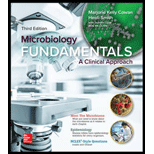
Microbiology Fundamentals: A Clinical Approach
3rd Edition
ISBN: 9781259709227
Author: Marjorie Kelly Cowan Professor, Heidi Smith
Publisher: McGraw-Hill Education
expand_more
expand_more
format_list_bulleted
Concept explainers
Question
Chapter 18, Problem 6Q
Summary Introduction
To construct:
An immunological argument about the reason why Lyme disease might continue to cause symptoms after the bacterium has been cleared.
Introduction:
Lyme disease or Lyme borreliosis is an infectious bacterial disease, which is spread by ticks. It is caused by four main species of bacteria such as Borrelia burgdoferi, Borrelia mayonii, Borrelia afzeii, and Borrelia garinii.
Expert Solution & Answer
Want to see the full answer?
Check out a sample textbook solution
Students have asked these similar questions
What is the structure and function of Eukaryotic cells, including their organelles? How are Eukaryotic cells different than Prokaryotic cells, in terms of evolution which form of the cell might have came first? How do Eukaryotic cells become malignant (cancerous)?
What are the roles of DNA and proteins inside of the cell? What are the building blocks or molecular components of the DNA and proteins? How are proteins produced within the cell? What connection is there between DNA, proteins, and the cell cycle? What is the relationship between DNA, proteins, and Cancer?
Why cells go through various types of cell division and how eukaryotic cells control cell growth through the cell cycle control system?
Chapter 18 Solutions
Microbiology Fundamentals: A Clinical Approach
Ch. 18.1 - Describe the important anatomical features of the...Ch. 18.1 - List the natural defenses present in the...Ch. 18.1 - Prob. 1NPCh. 18.2 - Explain the what and the why of the normal biota...Ch. 18.3 - List the possible causative agents, modes of...Ch. 18.3 - Discuss the epidemiology of malaria.Ch. 18.3 - Prob. 6AYPCh. 18.3 - Discuss the important features of infectious...Ch. 18.3 - Prob. 8AYPCh. 18.3 - Prob. 9AYP
Ch. 18.3 - Prob. 10AYPCh. 18.3 - Prob. 11AYPCh. 18.3 - Prob. 2NPCh. 18.3 - Prob. 3NPCh. 18.3 - Prob. 1MMCh. 18.3 - Prob. 2MMCh. 18.3 - Prob. 4NPCh. 18.3 - Q. Look at the deadliness of Ebola in the feature...Ch. 18.3 - Prob. 5NPCh. 18 - Which of the following microbes have evolved an...Ch. 18 - Why do you think that malarial infection is more...Ch. 18 - In chapter 17 you were asked to speculate on why a...Ch. 18 - Which of the following is a G+ bacterium? a....Ch. 18 - What characteristic(s) of Bacillus anthracis make...Ch. 18 - Prob. 6QCh. 18 - Prob. 7QCh. 18 - Prob. 8QCh. 18 - Argue for the bloodstream being an advantageous...Ch. 18 - Prob. 10QCh. 18 - Prob. 11QCh. 18 - Use a unique characteristic of HIV to provide an...Ch. 18 - Prob. 13QCh. 18 - Prob. 14QCh. 18 - This text frequently discusses the increase in...Ch. 18 - Normal biota found in the oral cavity are most...Ch. 18 - Prob. 17QCh. 18 - For decades public health officials have been...Ch. 18 - Lyme disease is most likely to occur in a. North...Ch. 18 - Prob. 20QCh. 18 - When female mosquitoes mate with males infected...Ch. 18 - Prob. 1VC
Knowledge Booster
Learn more about
Need a deep-dive on the concept behind this application? Look no further. Learn more about this topic, biology and related others by exploring similar questions and additional content below.Similar questions
- In one paragraph show how atoms and they're structure are related to the structure of dna and proteins. Talk about what atoms are. what they're made of, why chemical bonding is important to DNA?arrow_forwardWhat are the structure and properties of atoms and chemical bonds (especially how they relate to DNA and proteins).arrow_forwardThe Sentinel Cell: Nature’s Answer to Cancer?arrow_forward
- Molecular Biology Question You are working to characterize a novel protein in mice. Analysis shows that high levels of the primary transcript that codes for this protein are found in tissue from the brain, muscle, liver, and pancreas. However, an antibody that recognizes the C-terminal portion of the protein indicates that the protein is present in brain, muscle, and liver, but not in the pancreas. What is the most likely explanation for this result?arrow_forwardMolecular Biology Explain/discuss how “slow stop” and “quick/fast stop” mutants wereused to identify different protein involved in DNA replication in E. coli.arrow_forwardMolecular Biology Question A gene that codes for a protein was removed from a eukaryotic cell and inserted into a prokaryotic cell. Although the gene was successfully transcribed and translated, it produced a different protein than it produced in the eukaryotic cell. What is the most likely explanation?arrow_forward
- Molecular Biology LIST three characteristics of origins of replicationarrow_forwardMolecular Biology Question Please help. Thank you For E coli DNA polymerase III, give the structure and function of the b-clamp sub-complex. Describe how the structure of this sub-complex is important for it’s function.arrow_forwardMolecular Biology LIST three characteristics of DNA Polymerasesarrow_forward
arrow_back_ios
SEE MORE QUESTIONS
arrow_forward_ios
Recommended textbooks for you
 Comprehensive Medical Assisting: Administrative a...NursingISBN:9781305964792Author:Wilburta Q. Lindh, Carol D. Tamparo, Barbara M. Dahl, Julie Morris, Cindy CorreaPublisher:Cengage Learning
Comprehensive Medical Assisting: Administrative a...NursingISBN:9781305964792Author:Wilburta Q. Lindh, Carol D. Tamparo, Barbara M. Dahl, Julie Morris, Cindy CorreaPublisher:Cengage Learning

Comprehensive Medical Assisting: Administrative a...
Nursing
ISBN:9781305964792
Author:Wilburta Q. Lindh, Carol D. Tamparo, Barbara M. Dahl, Julie Morris, Cindy Correa
Publisher:Cengage Learning




